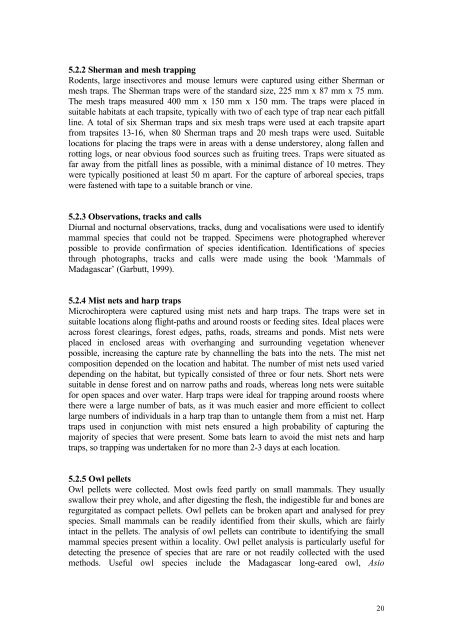The proposed Parc Regional de Belomotse - Frontier-publications ...
The proposed Parc Regional de Belomotse - Frontier-publications ...
The proposed Parc Regional de Belomotse - Frontier-publications ...
Create successful ePaper yourself
Turn your PDF publications into a flip-book with our unique Google optimized e-Paper software.
5.2.2 Sherman and mesh trapping<br />
Ro<strong>de</strong>nts, large insectivores and mouse lemurs were captured using either Sherman or<br />
mesh traps. <strong>The</strong> Sherman traps were of the standard size, 225 mm x 87 mm x 75 mm.<br />
<strong>The</strong> mesh traps measured 400 mm x 150 mm x 150 mm. <strong>The</strong> traps were placed in<br />
suitable habitats at each trapsite, typically with two of each type of trap near each pitfall<br />
line. A total of six Sherman traps and six mesh traps were used at each trapsite apart<br />
from trapsites 13-16, when 80 Sherman traps and 20 mesh traps were used. Suitable<br />
locations for placing the traps were in areas with a <strong>de</strong>nse un<strong>de</strong>rstorey, along fallen and<br />
rotting logs, or near obvious food sources such as fruiting trees. Traps were situated as<br />
far away from the pitfall lines as possible, with a minimal distance of 10 metres. <strong>The</strong>y<br />
were typically positioned at least 50 m apart. For the capture of arboreal species, traps<br />
were fastened with tape to a suitable branch or vine.<br />
5.2.3 Observations, tracks and calls<br />
Diurnal and nocturnal observations, tracks, dung and vocalisations were used to i<strong>de</strong>ntify<br />
mammal species that could not be trapped. Specimens were photographed wherever<br />
possible to provi<strong>de</strong> confirmation of species i<strong>de</strong>ntification. I<strong>de</strong>ntifications of species<br />
through photographs, tracks and calls were ma<strong>de</strong> using the book ‘Mammals of<br />
Madagascar’ (Garbutt, 1999).<br />
5.2.4 Mist nets and harp traps<br />
Microchiroptera were captured using mist nets and harp traps. <strong>The</strong> traps were set in<br />
suitable locations along flight-paths and around roosts or feeding sites. I<strong>de</strong>al places were<br />
across forest clearings, forest edges, paths, roads, streams and ponds. Mist nets were<br />
placed in enclosed areas with overhanging and surrounding vegetation whenever<br />
possible, increasing the capture rate by channelling the bats into the nets. <strong>The</strong> mist net<br />
composition <strong>de</strong>pen<strong>de</strong>d on the location and habitat. <strong>The</strong> number of mist nets used varied<br />
<strong>de</strong>pending on the habitat, but typically consisted of three or four nets. Short nets were<br />
suitable in <strong>de</strong>nse forest and on narrow paths and roads, whereas long nets were suitable<br />
for open spaces and over water. Harp traps were i<strong>de</strong>al for trapping around roosts where<br />
there were a large number of bats, as it was much easier and more efficient to collect<br />
large numbers of individuals in a harp trap than to untangle them from a mist net. Harp<br />
traps used in conjunction with mist nets ensured a high probability of capturing the<br />
majority of species that were present. Some bats learn to avoid the mist nets and harp<br />
traps, so trapping was un<strong>de</strong>rtaken for no more than 2-3 days at each location.<br />
5.2.5 Owl pellets<br />
Owl pellets were collected. Most owls feed partly on small mammals. <strong>The</strong>y usually<br />
swallow their prey whole, and after digesting the flesh, the indigestible fur and bones are<br />
regurgitated as compact pellets. Owl pellets can be broken apart and analysed for prey<br />
species. Small mammals can be readily i<strong>de</strong>ntified from their skulls, which are fairly<br />
intact in the pellets. <strong>The</strong> analysis of owl pellets can contribute to i<strong>de</strong>ntifying the small<br />
mammal species present within a locality. Owl pellet analysis is particularly useful for<br />
<strong>de</strong>tecting the presence of species that are rare or not readily collected with the used<br />
methods. Useful owl species inclu<strong>de</strong> the Madagascar long-eared owl, Asio<br />
20
















